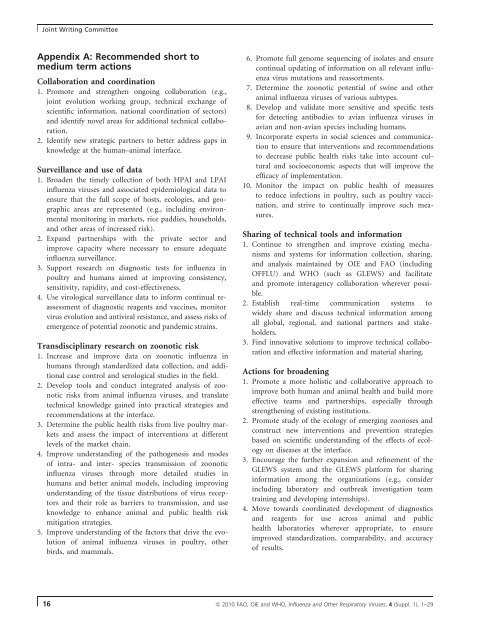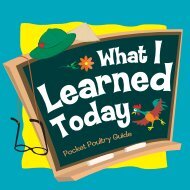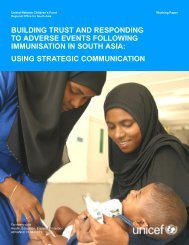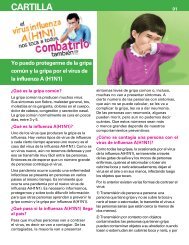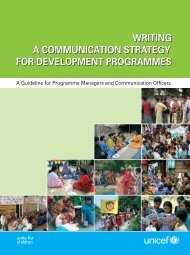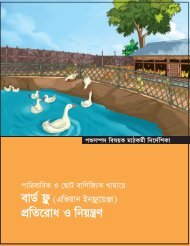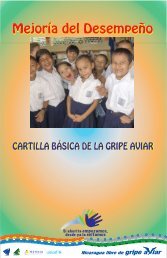FAO-OIE-WHO Joint Technical Consultation on Avian Influenza at ...
FAO-OIE-WHO Joint Technical Consultation on Avian Influenza at ...
FAO-OIE-WHO Joint Technical Consultation on Avian Influenza at ...
- No tags were found...
Create successful ePaper yourself
Turn your PDF publications into a flip-book with our unique Google optimized e-Paper software.
<str<strong>on</strong>g>Joint</str<strong>on</strong>g> Writing CommitteeAppendix A: Recommended short tomedium term acti<strong>on</strong>sCollabor<strong>at</strong>i<strong>on</strong> and coordin<strong>at</strong>i<strong>on</strong>1. Promote and strengthen <strong>on</strong>going collabor<strong>at</strong>i<strong>on</strong> (e.g.,joint evoluti<strong>on</strong> working group, technical exchange ofscientific inform<strong>at</strong>i<strong>on</strong>, n<strong>at</strong>i<strong>on</strong>al coordin<strong>at</strong>i<strong>on</strong> of sectors)and identify novel areas for additi<strong>on</strong>al technical collabor<strong>at</strong>i<strong>on</strong>.2. Identify new str<strong>at</strong>egic partners to better address gaps inknowledge <strong>at</strong> the human–animal interface.Surveillance and use of d<strong>at</strong>a1. Broaden the timely collecti<strong>on</strong> of both HPAI and LPAIinfluenza viruses and associ<strong>at</strong>ed epidemiological d<strong>at</strong>a toensure th<strong>at</strong> the full scope of hosts, ecologies, and geographicareas are represented (e.g., including envir<strong>on</strong>mentalm<strong>on</strong>itoring in markets, rice paddies, households,and other areas of increased risk).2. Expand partnerships with the priv<strong>at</strong>e sector andimprove capacity where necessary to ensure adequ<strong>at</strong>einfluenza surveillance.3. Support research <strong>on</strong> diagnostic tests for influenza inpoultry and humans aimed <strong>at</strong> improving c<strong>on</strong>sistency,sensitivity, rapidity, and cost-effectiveness.4. Use virological surveillance d<strong>at</strong>a to inform c<strong>on</strong>tinual reassessmentof diagnostic reagents and vaccines, m<strong>on</strong>itorvirus evoluti<strong>on</strong> and antiviral resistance, and assess risks ofemergence of potential zo<strong>on</strong>otic and pandemic strains.Transdisciplinary research <strong>on</strong> zo<strong>on</strong>otic risk1. Increase and improve d<strong>at</strong>a <strong>on</strong> zo<strong>on</strong>otic influenza inhumans through standardized d<strong>at</strong>a collecti<strong>on</strong>, and additi<strong>on</strong>alcase c<strong>on</strong>trol and serological studies in the field.2. Develop tools and c<strong>on</strong>duct integr<strong>at</strong>ed analysis of zo<strong>on</strong>oticrisks from animal influenza viruses, and transl<strong>at</strong>etechnical knowledge gained into practical str<strong>at</strong>egies andrecommend<strong>at</strong>i<strong>on</strong>s <strong>at</strong> the interface.3. Determine the public health risks from live poultry marketsand assess the impact of interventi<strong>on</strong>s <strong>at</strong> differentlevels of the market chain.4. Improve understanding of the p<strong>at</strong>hogenesis and modesof intra- and inter- species transmissi<strong>on</strong> of zo<strong>on</strong>oticinfluenza viruses through more detailed studies inhumans and better animal models, including improvingunderstanding of the tissue distributi<strong>on</strong>s of virus receptorsand their role as barriers to transmissi<strong>on</strong>, and useknowledge to enhance animal and public health riskmitig<strong>at</strong>i<strong>on</strong> str<strong>at</strong>egies.5. Improve understanding of the factors th<strong>at</strong> drive the evoluti<strong>on</strong>of animal influenza viruses in poultry, otherbirds, and mammals.6. Promote full genome sequencing of isol<strong>at</strong>es and ensurec<strong>on</strong>tinual upd<strong>at</strong>ing of inform<strong>at</strong>i<strong>on</strong> <strong>on</strong> all relevant influenzavirus mut<strong>at</strong>i<strong>on</strong>s and reassortments.7. Determine the zo<strong>on</strong>otic potential of swine and otheranimal influenza viruses of various subtypes.8. Develop and valid<strong>at</strong>e more sensitive and specific testsfor detecting antibodies to avian influenza viruses inavian and n<strong>on</strong>-avian species including humans.9. Incorpor<strong>at</strong>e experts in social sciences and communic<strong>at</strong>i<strong>on</strong>to ensure th<strong>at</strong> interventi<strong>on</strong>s and recommend<strong>at</strong>i<strong>on</strong>sto decrease public health risks take into account culturaland socioec<strong>on</strong>omic aspects th<strong>at</strong> will improve theefficacy of implement<strong>at</strong>i<strong>on</strong>.10. M<strong>on</strong>itor the impact <strong>on</strong> public health of measuresto reduce infecti<strong>on</strong>s in poultry, such as poultry vaccin<strong>at</strong>i<strong>on</strong>,and strive to c<strong>on</strong>tinually improve such measures.Sharing of technical tools and inform<strong>at</strong>i<strong>on</strong>1. C<strong>on</strong>tinue to strengthen and improve existing mechanismsand systems for inform<strong>at</strong>i<strong>on</strong> collecti<strong>on</strong>, sharing,and analysis maintained by <str<strong>on</strong>g>OIE</str<strong>on</strong>g> and <str<strong>on</strong>g>FAO</str<strong>on</strong>g> (includingOFFLU) and <str<strong>on</strong>g>WHO</str<strong>on</strong>g> (such as GLEWS) and facilit<strong>at</strong>eand promote interagency collabor<strong>at</strong>i<strong>on</strong> wherever possible.2. Establish real-time communic<strong>at</strong>i<strong>on</strong> systems towidely share and discuss technical inform<strong>at</strong>i<strong>on</strong> am<strong>on</strong>gall global, regi<strong>on</strong>al, and n<strong>at</strong>i<strong>on</strong>al partners and stakeholders.3. Find innov<strong>at</strong>ive soluti<strong>on</strong>s to improve technical collabor<strong>at</strong>i<strong>on</strong>and effective inform<strong>at</strong>i<strong>on</strong> and m<strong>at</strong>erial sharing.Acti<strong>on</strong>s for broadening1. Promote a more holistic and collabor<strong>at</strong>ive approach toimprove both human and animal health and build moreeffective teams and partnerships, especially throughstrengthening of existing instituti<strong>on</strong>s.2. Promote study of the ecology of emerging zo<strong>on</strong>oses andc<strong>on</strong>struct new interventi<strong>on</strong>s and preventi<strong>on</strong> str<strong>at</strong>egiesbased <strong>on</strong> scientific understanding of the effects of ecology<strong>on</strong> diseases <strong>at</strong> the interface.3. Encourage the further expansi<strong>on</strong> and refinement of theGLEWS system and the GLEWS pl<strong>at</strong>form for sharinginform<strong>at</strong>i<strong>on</strong> am<strong>on</strong>g the organiz<strong>at</strong>i<strong>on</strong>s (e.g., c<strong>on</strong>siderincluding labor<strong>at</strong>ory and outbreak investig<strong>at</strong>i<strong>on</strong> teamtraining and developing internships).4. Move towards coordin<strong>at</strong>ed development of diagnosticsand reagents for use across animal and publichealth labor<strong>at</strong>ories wherever appropri<strong>at</strong>e, to ensureimproved standardiz<strong>at</strong>i<strong>on</strong>, comparability, and accuracyof results.16 ª 2010 <str<strong>on</strong>g>FAO</str<strong>on</strong>g>, <str<strong>on</strong>g>OIE</str<strong>on</strong>g> and <str<strong>on</strong>g>WHO</str<strong>on</strong>g>, <strong>Influenza</strong> and Other Respir<strong>at</strong>ory Viruses, 4 (Suppl. 1), 1–29


